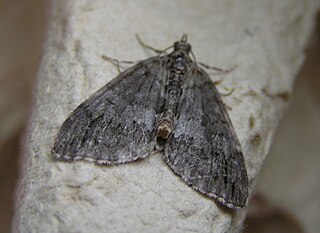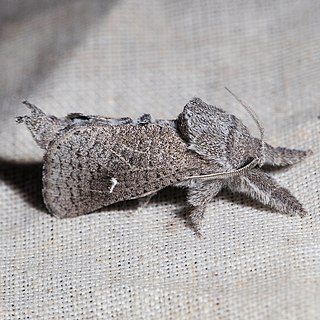
Euchaetes is a genus of moths in the family Erebidae. It was described by Thaddeus William Harris in 1841.
Noctueliopsis is a genus of moths of the family Crambidae.

Anarta is a genus of moths of the family Noctuidae.
Euamiana is a genus of moths of the family Noctuidae erected by William Barnes and Foster Hendrickson Benjamin in 1927.

Grotella is a genus of moths of the family Noctuidae first described by Leon F. Harvey in 1875.

Ponometia is a genus of moths of the family Noctuidae. The genus was erected by Gottlieb August Wilhelm Herrich-Schäffer in 1868.
Provia argentata is the only species in the monotypic moth genus Provia of the family Noctuidae. It is found in the US state of Utah. Both the genus and species were first described by William Barnes and James Halliday McDunnough in 1910.

Hydriomena is a genus of moths in the family Geometridae described by Jacob Hübner in 1825.

Nemoria is a genus of emerald moths in the family Geometridae. It was named by Jacob Hübner in 1818.
Prorella is a genus of moths in the family Geometridae erected by William Barnes and James Halliday McDunnough in 1918.

Anhypotrix tristis is a moth of the family Noctuidae first described by William Barnes and James Halliday McDunnough in 1910. It is found from eastern Arizona and northern New Mexico southward in the Sierra Madre Occidental to the state of Durango in Mexico.
Euchaetes gigantea is a moth of the family Erebidae. It was described by William Barnes and James Halliday McDunnough in 1910. It is found in the US states of Arizona, New Mexico and Oklahoma.
Pseudohemihyalea splendens is a moth in the family Erebidae. It was described by William Barnes and James Halliday McDunnough in 1910. It is found from south-eastern Arizona in the US to Mexico.
Givira is a genus of moths in the family Cossidae.

Hypopta palmata is a moth in the family Cossidae first described by William Barnes and James Halliday McDunnough in 1910. It is found in North America, where it has been recorded from western Texas, Arizona, Nevada, California and Baja California Norte. The habitat consists of deserts and desert mountains.

Givira lotta, the pine carpenterworm moth, is a moth in the family Cossidae. The species was first described by William Barnes and James Halliday McDunnough in 1910. It is found in the United States, where it has been recorded from California, Arizona, New Mexico and Colorado. The habitat consists of pine forests.

Givira marga is a moth in the family Cossidae first described by William Barnes and James Halliday McDunnough in 1910. It is found in North America, where it has been recorded from California and Arizona.

Givira minuta is a moth in the family Cossidae first described by William Barnes and James Halliday McDunnough in 1910. It is found in North America, where it has been recorded from southern Arizona.
Hamilcara is a monotypic moth genus in the family Cossidae. Its only species, Hamilcara atra, is found in North America, where it has been recorded from Arizona. The genus and species were first described by William Barnes and James Halliday McDunnough in 1910.
Psychonoctua gilensis is a moth in the family Cossidae first described by William Barnes and James Halliday McDunnough in 1910. It is found in North America, where it has been recorded from California and Arizona.








